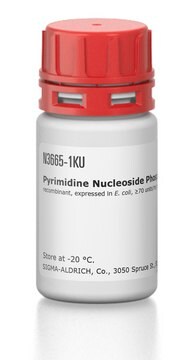SRE0006
Thymidine Phosphorylase, recombinant from Escherichia coli
recombinant, expressed in E. coli, Suitable for manufacturing of diagnostic kits and reagents, buffered aqueous solution, ≥500 units/mL
Synonyme(s) :
Gliostatins, PD-ECGF, Thymidine:orthophosphate deoxy-D-ribosyltransferase
About This Item
Produits recommandés
Produit recombinant
expressed in E. coli
Niveau de qualité
Forme
buffered aqueous solution
Concentration
≥500 units/mL
Technique(s)
inhibition assay: suitable
Couleur
colorless to yellow
Solubilité
soluble
water: soluble
Numéro d'accès NCBI
Numéro d'accès UniProt
Application(s)
diagnostic assay manufacturing
Conditions d'expédition
wet ice
Température de stockage
2-8°C
Informations sur le gène
Escherichia coli ... deoA(948901)
Vous recherchez des produits similaires ? Visite Guide de comparaison des produits
Description générale
The E. coli thymidine phosphorylase shares 40% sequence homology with the human sequence, which is identical to the angiogenic agent platelet-derived endothelial growth factor. The purified E. coli enzyme has been shown to stimulate blood vessel growth in chick chorioallantoic membrane assays.
Application
- in a study to evaluate biomarkers for advanced breast cancer patients treated with capecitabine-based first-line chemotherapy.
- in a study to investigate implications for the clinical efficacy of nucleoside analogues.
Actions biochimiques/physiologiques
Définition de l'unité
Notes préparatoires
Code de la classe de stockage
12 - Non Combustible Liquids
Classe de danger pour l'eau (WGK)
WGK 2
Point d'éclair (°F)
Not applicable
Point d'éclair (°C)
Not applicable
Certificats d'analyse (COA)
Recherchez un Certificats d'analyse (COA) en saisissant le numéro de lot du produit. Les numéros de lot figurent sur l'étiquette du produit après les mots "Lot" ou "Batch".
Déjà en possession de ce produit ?
Retrouvez la documentation relative aux produits que vous avez récemment achetés dans la Bibliothèque de documents.
Notre équipe de scientifiques dispose d'une expérience dans tous les secteurs de la recherche, notamment en sciences de la vie, science des matériaux, synthèse chimique, chromatographie, analyse et dans de nombreux autres domaines..
Contacter notre Service technique





